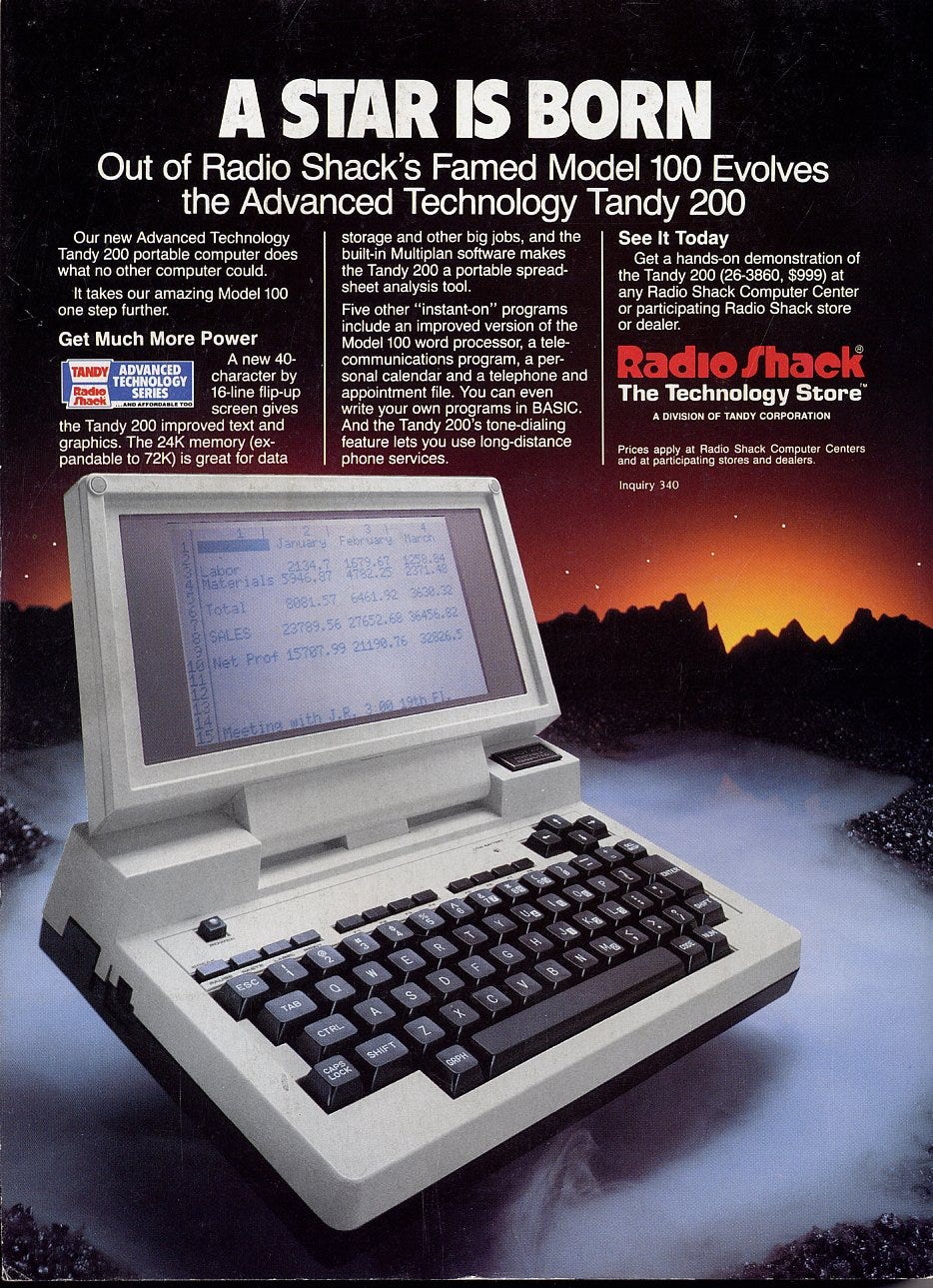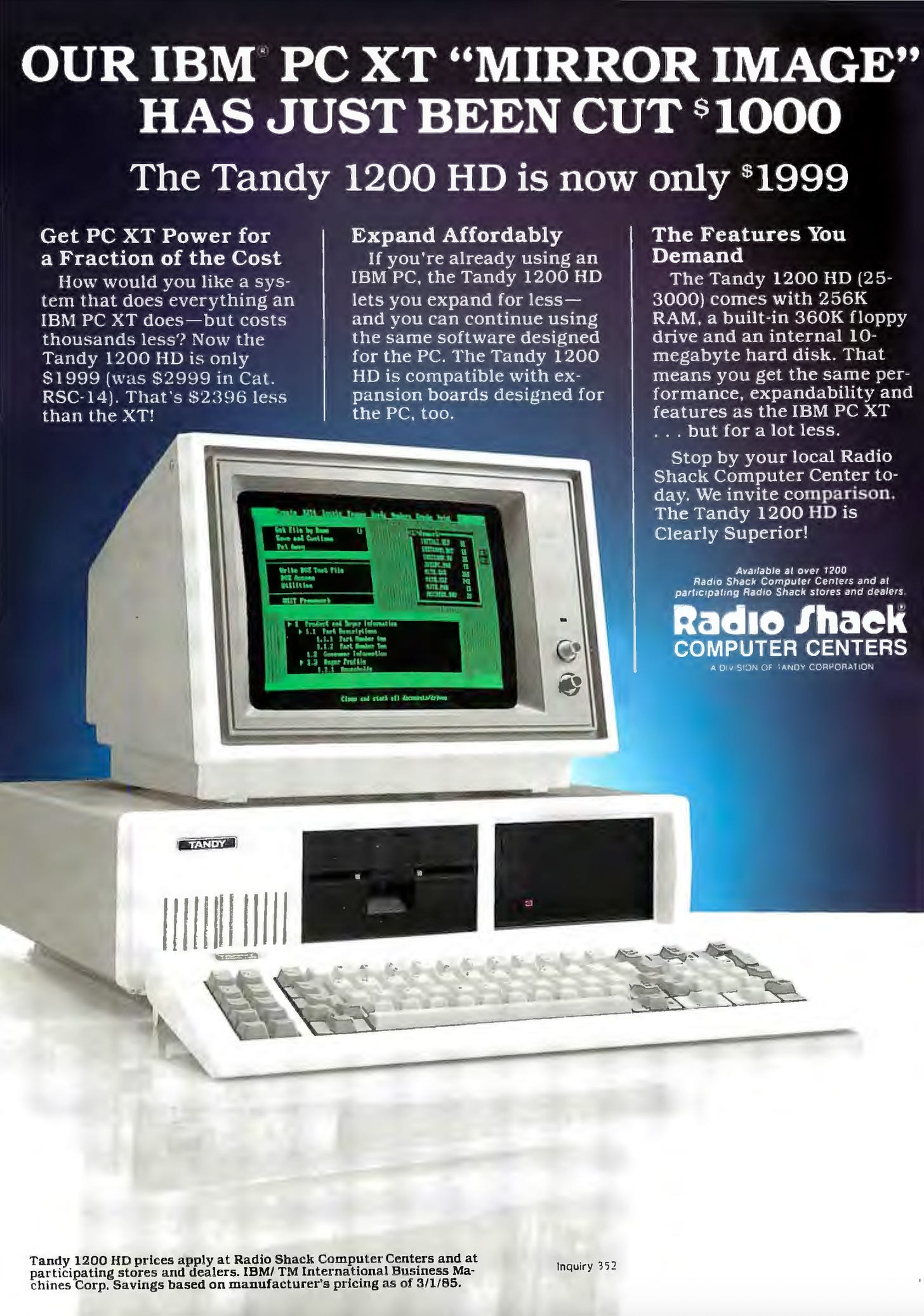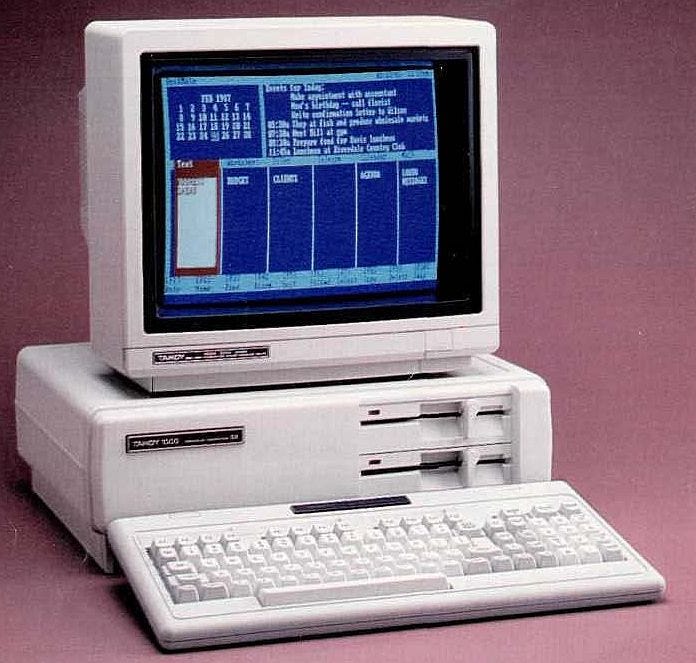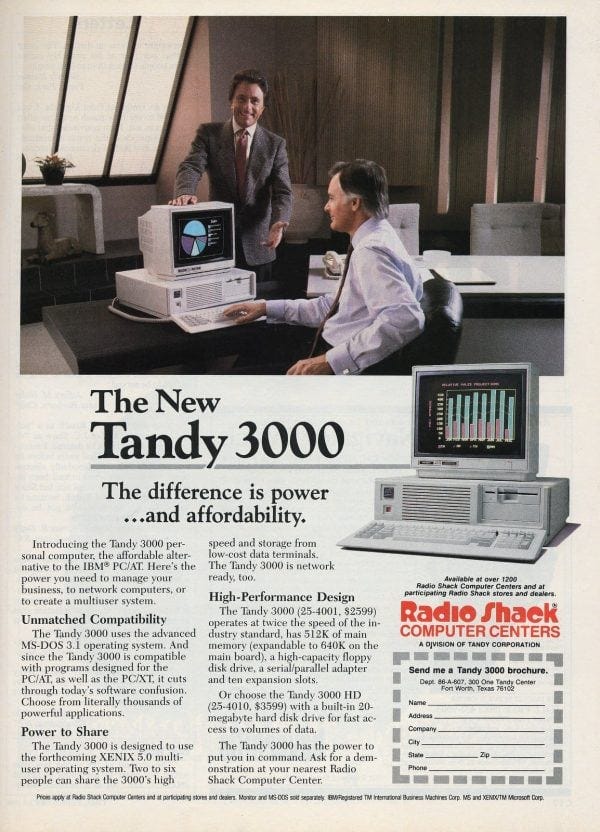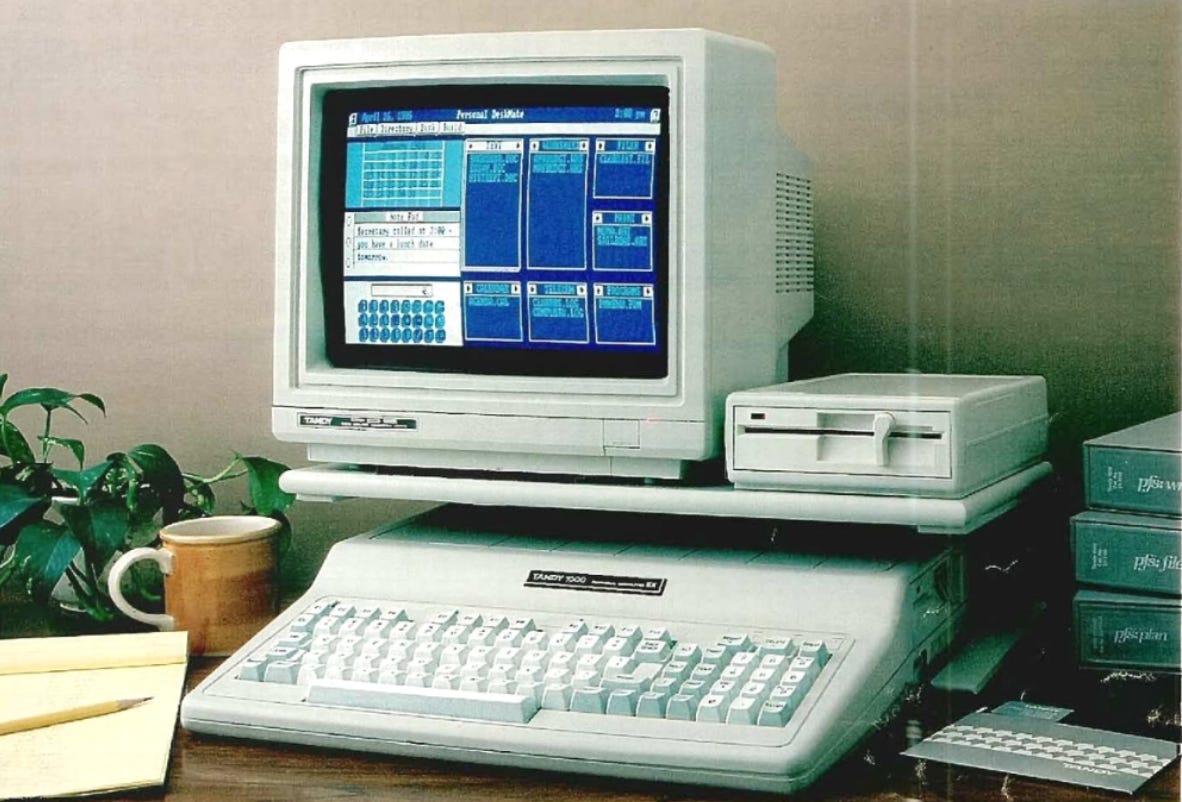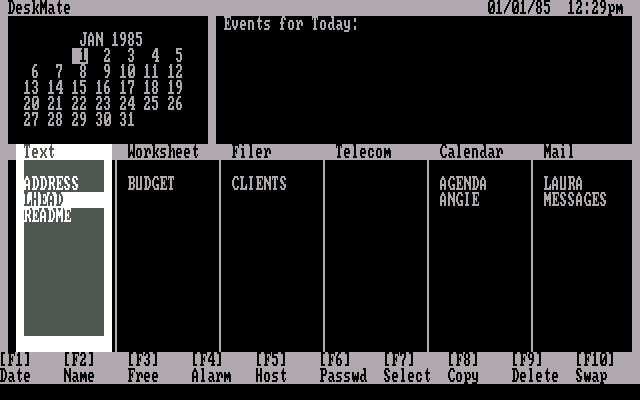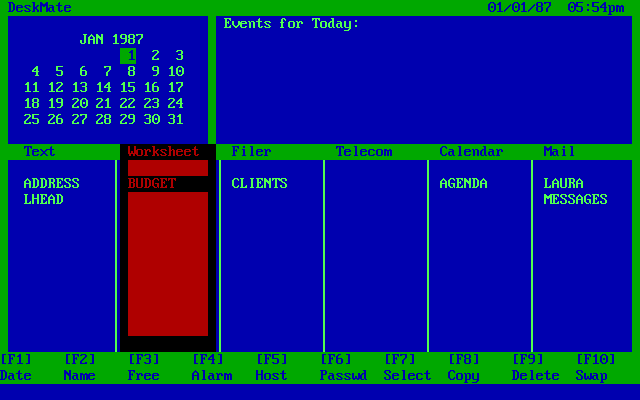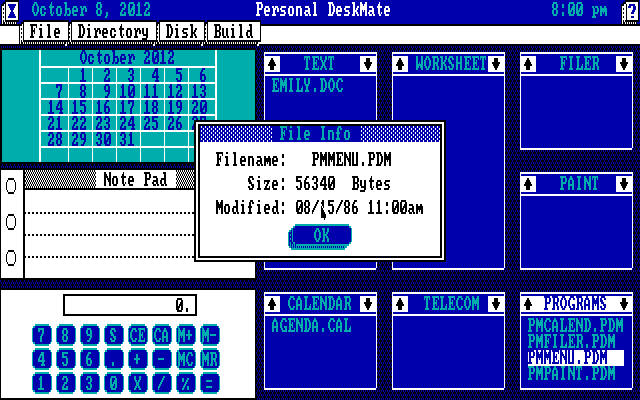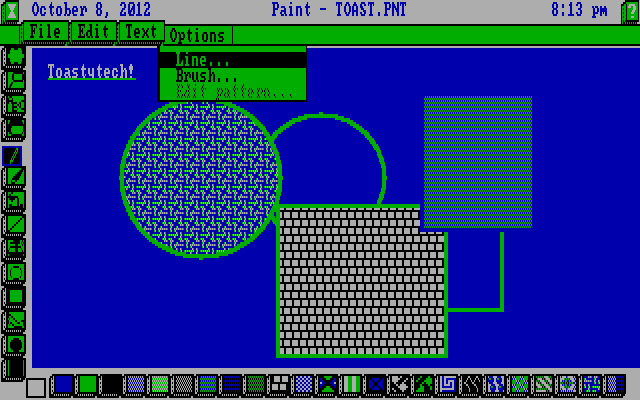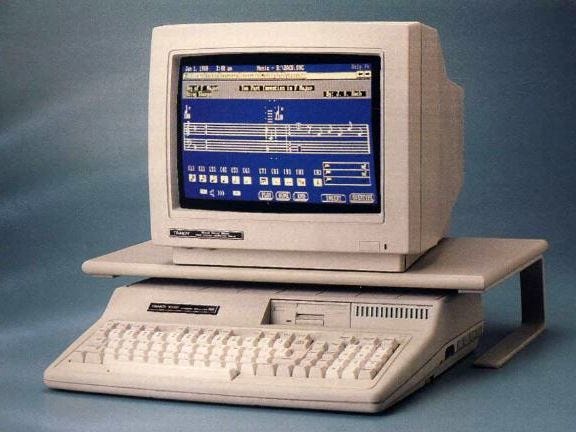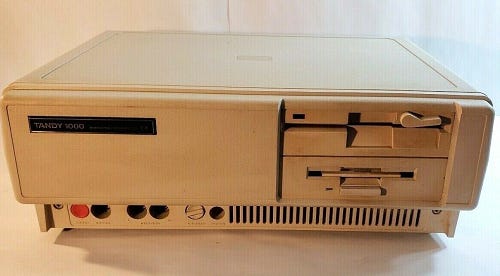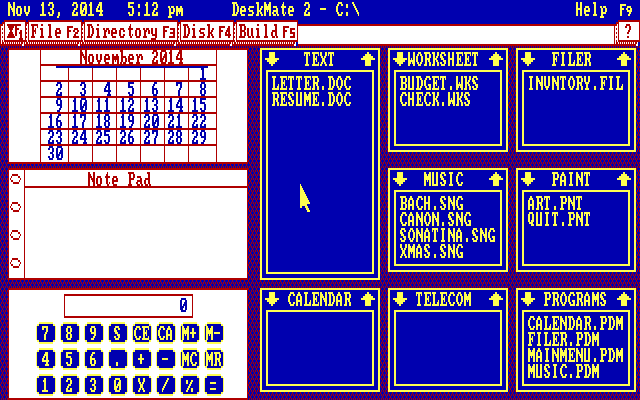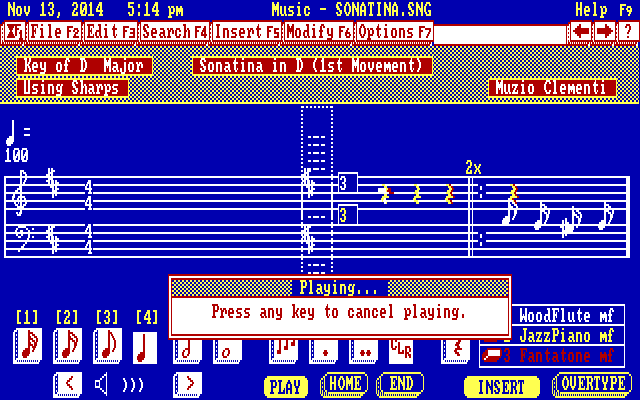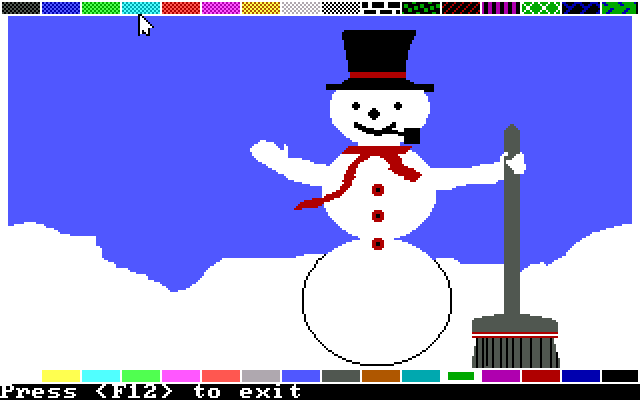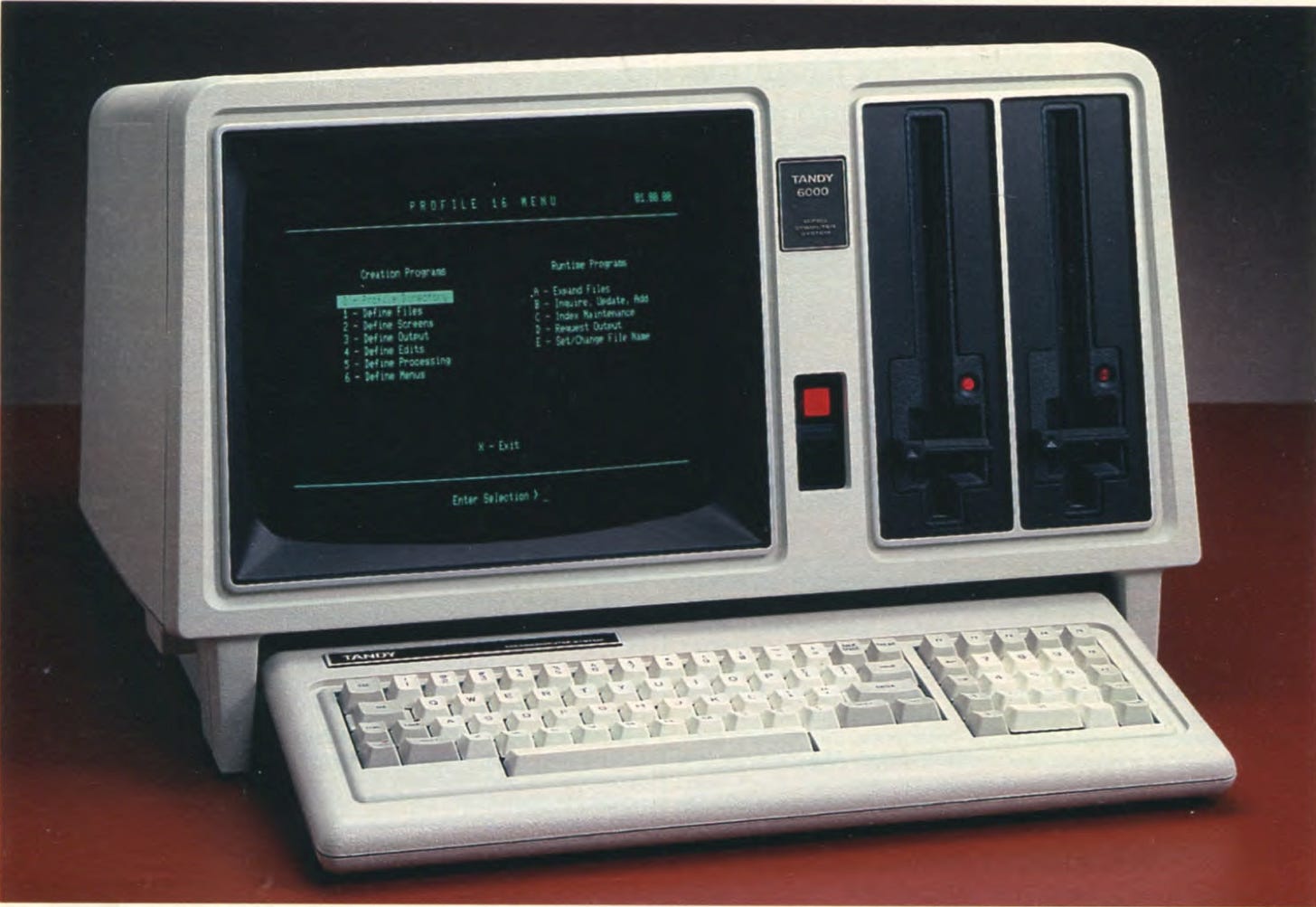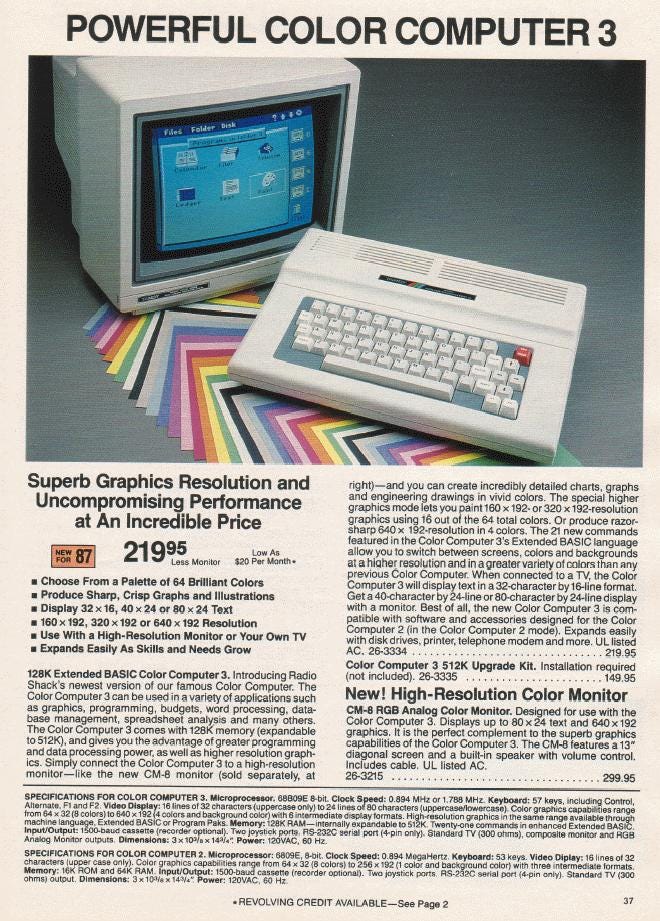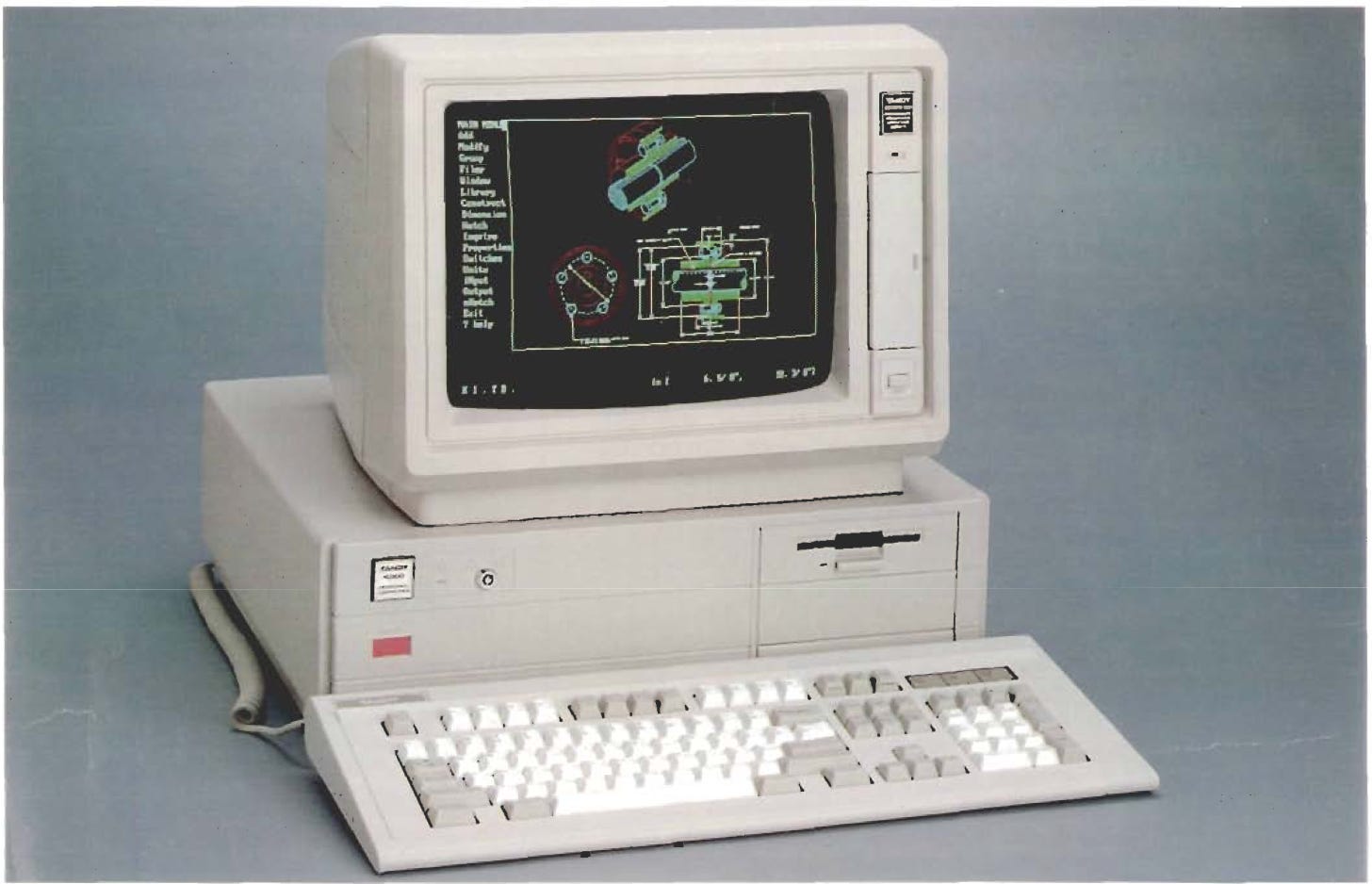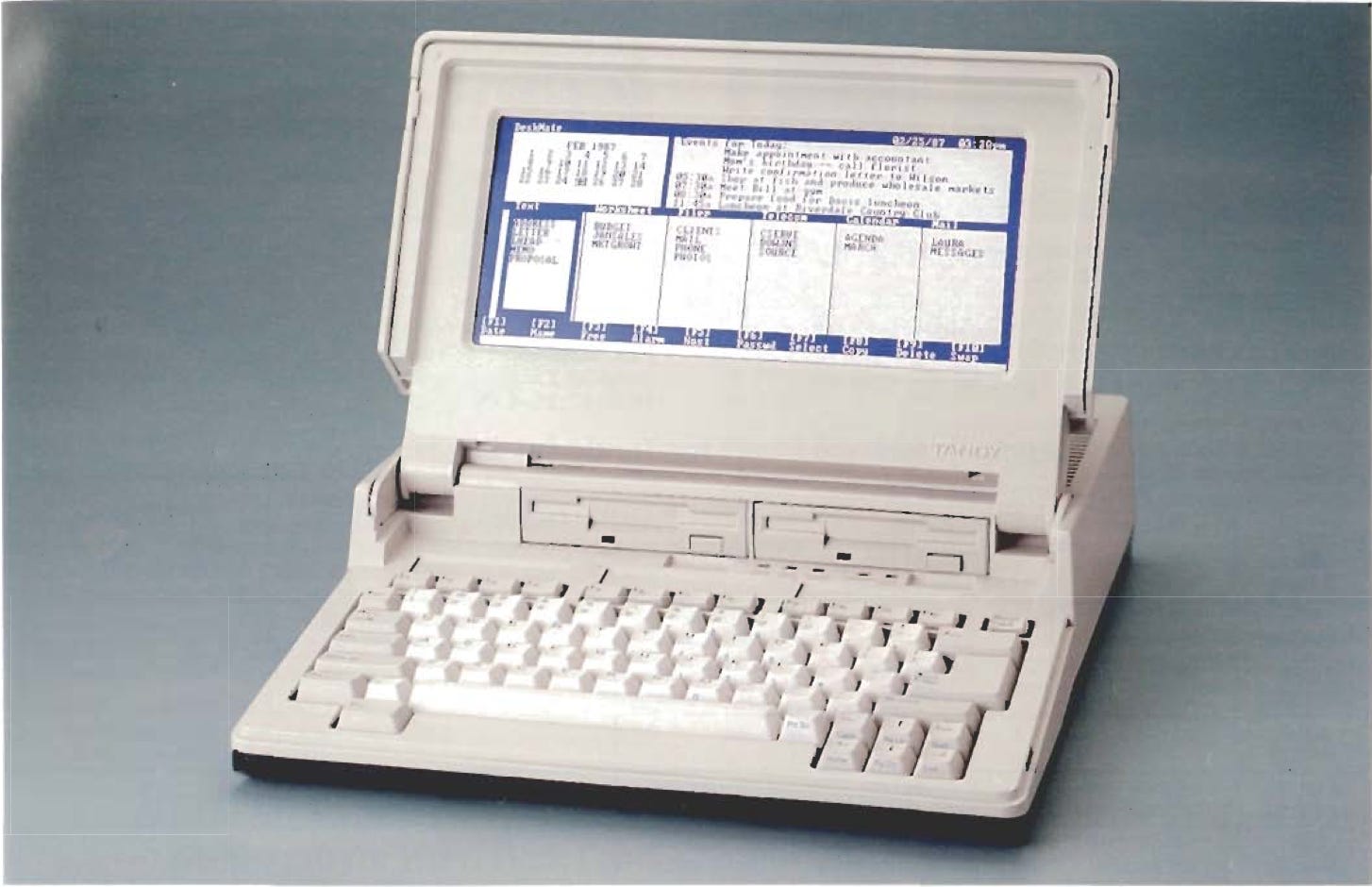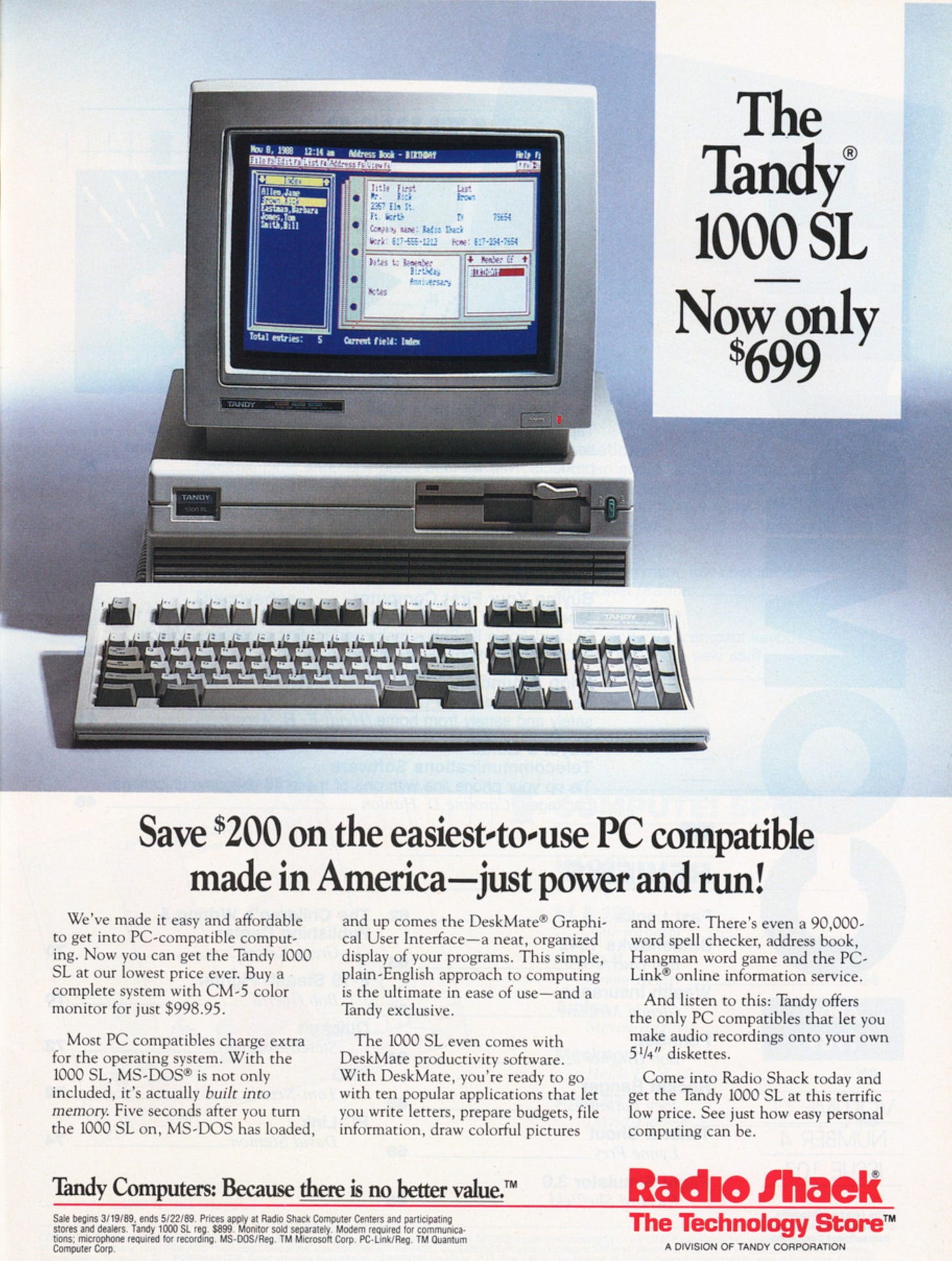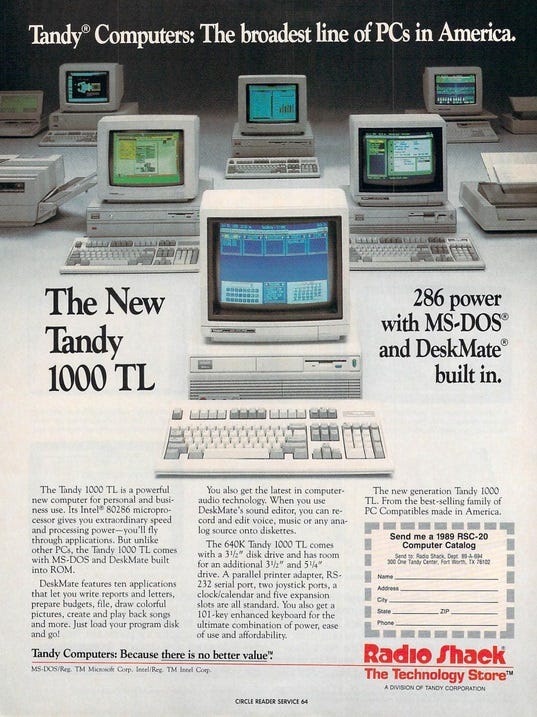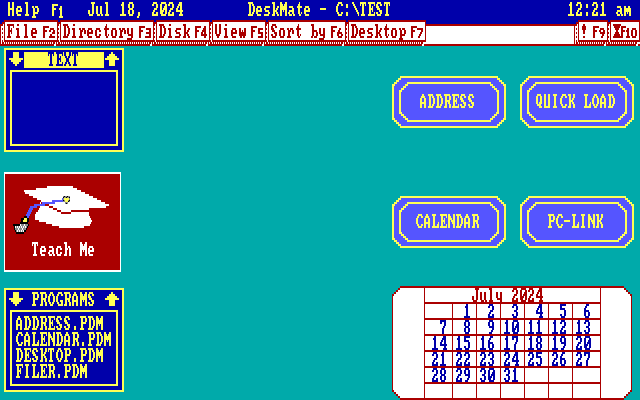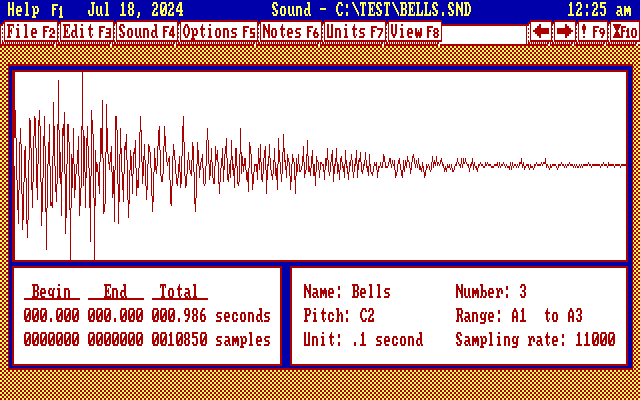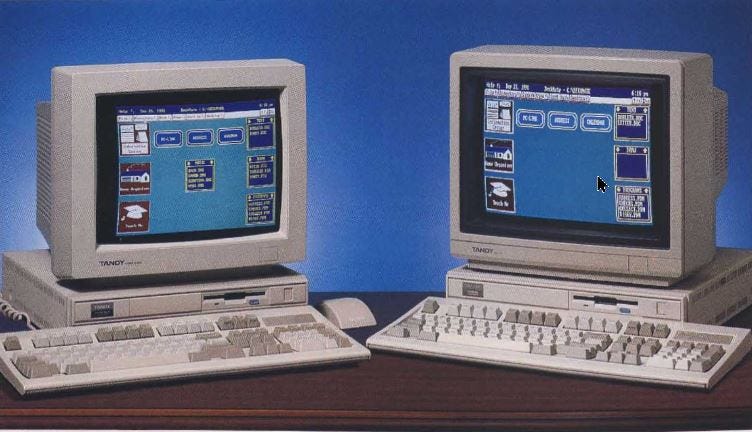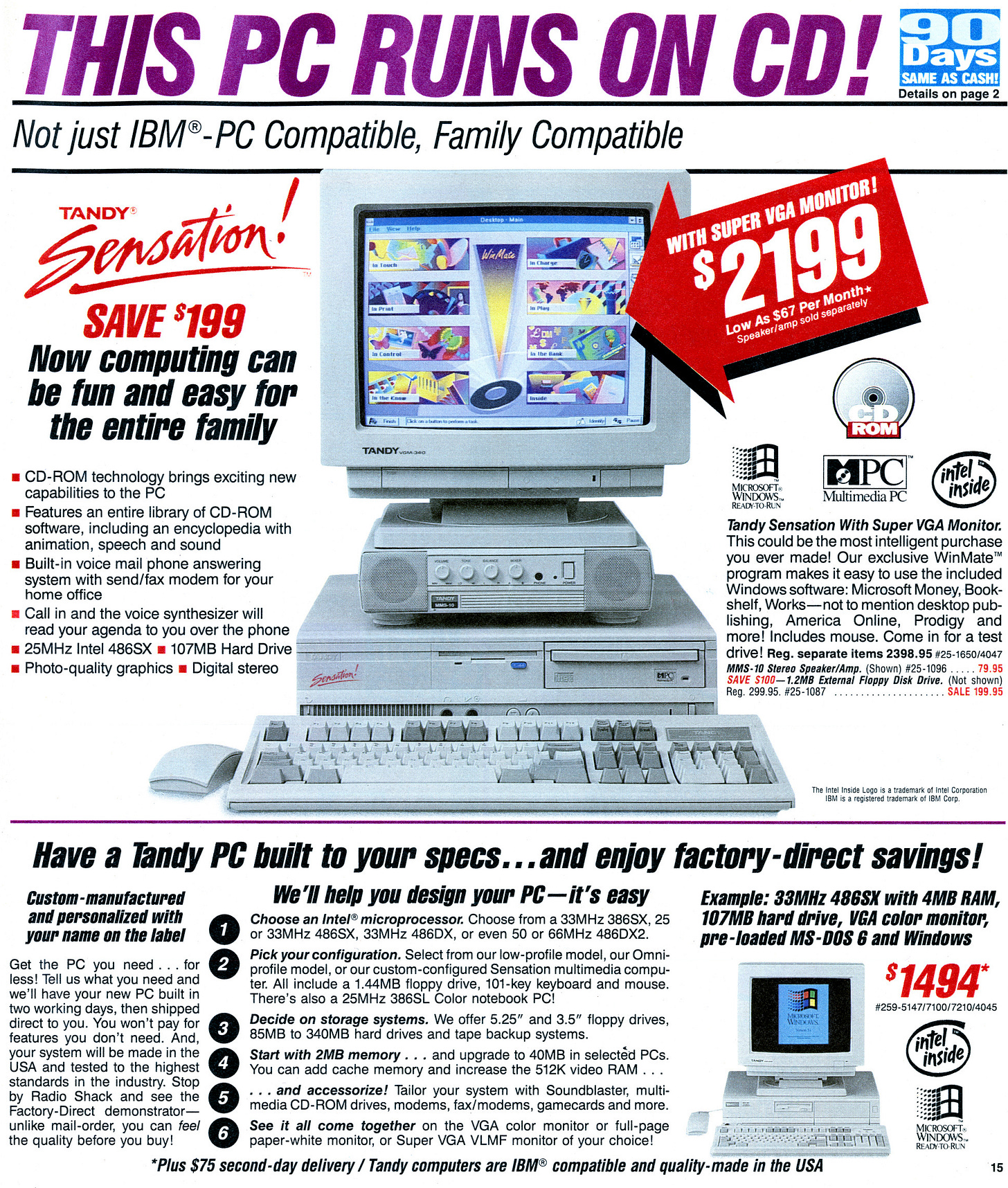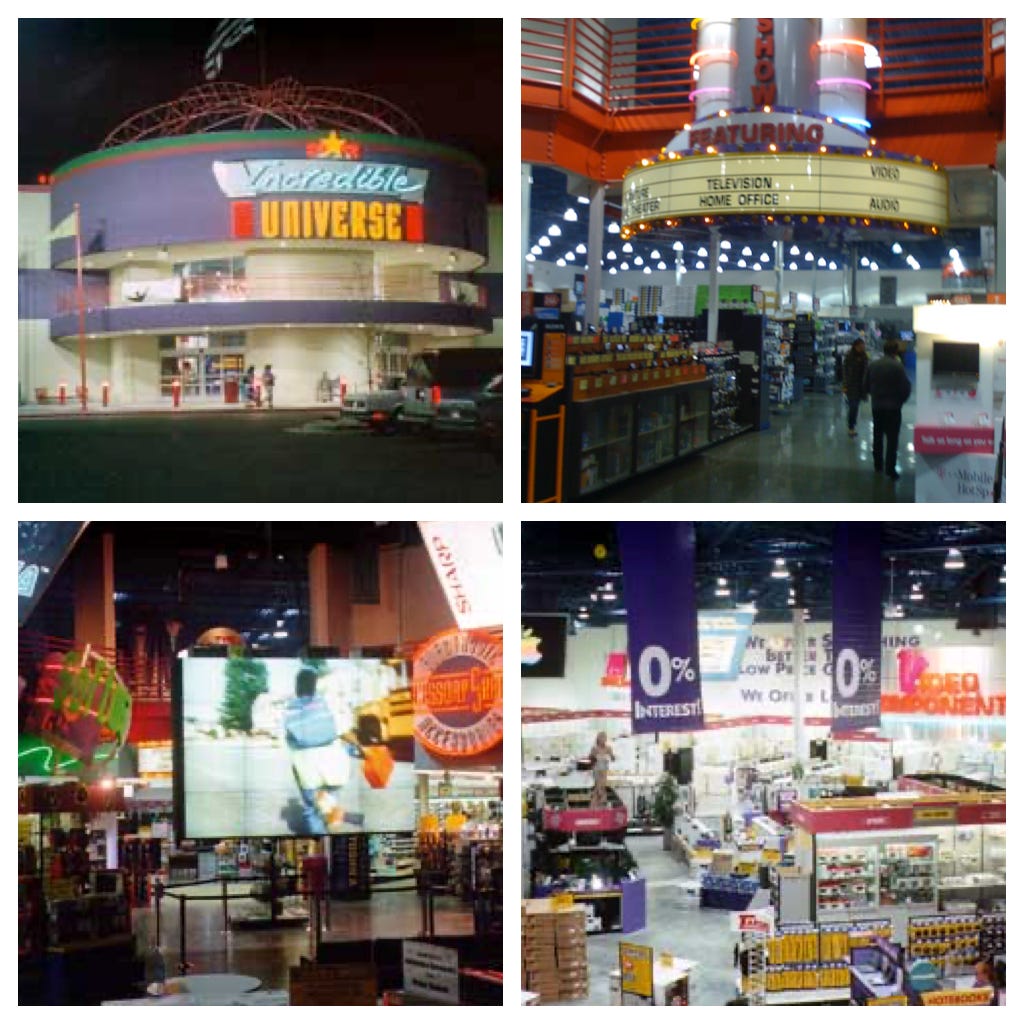Tandy Corporation, Part 4
The Decline and Fall
This article follows Part 1 of the Tandy Corporation’s history, which covers the company’s founding and the lead up to and launch of the TRS-80, and Part 2, which covers the TRS-80 Models I, II, III, CoCo, and Pocket Computer, and Part 3 which covers later 8bit models and Tandy’s first adventures with 16bit machines.
In 1984, Tandy moved the PC market forward in a major way with the Tandy 1000. A PC compatible had been created that was better than a PC, cheaper than a PC, and more compatible with IBM products than were IBM’s products themselves. While this kept Tandy in the computer business, it did not help the company recover its lost market share. Tandy held on to just shy of 10% of the home computer market by the end of the year.
Around the time the Tandy 1000 shipped, the Tandy 200 also shipped. The TRS-80 Model 100 had been the most successful laptop-like machine ever released, and Tandy was hoping to repeat that success. The company switched from a slab to what is recognizably a laptop (though it opens to only a single angle), moved to a 40-column by 16-line display (240 by 128 pixels for graphics), bumped RAM to 72K (three 24K banks) and ROM to 104K, rearranged the arrow keys into something better, and added Multiplan (supporting up to 63 columns by 99 rows). The form factor change and the larger display meant that the 200 measured 11.8 inches by 8.5 inches by 2.2 inches and weighed 4.5 pounds. Other hardware was roughly unchanged from the TRS-80 Model 100: 80C85, RS-232C, system bus connector, parallel printer support (output formatting now supported), phone (with the modem now supporting both tone and pulse dialing), cassette. Peripherals from the 100 were compatible with the 200 as one would expect, and all other software was likewise not much changed. Power could be provided by either an AC adapter or four AA batteries. Those batteries would supply 10 to 16 hours of run time. One rather cool update was that the 200 could support up to 255 alarms or short messages. Those alarms could be set weeks in advance and the computer would wake from sleep or even power-off to provide the reminder via a beep and a message across the bottom of the display. Blessedly, manuals were improved for the 200 with references for Multiplan, Telcom, BASIC, and the Tandy 200 Technical Reference Manual.
The Tandy 200 didn’t sell as well as the 100, and this was likely due to two different things: price, and compatibility. For a 200 with 24K RAM, a buyer would have parted with $999, and each additional 24K was $249.95. Then, by late 1984 and early 1985, the IBM compatibility issue was a serious one. The Tandy 200 launched around the same time as the Data General One. While the DG One cost more ($2,895) it offered far more: MS-DOS, an 8086 at 4MHz, base RAM of 128K (expandable to 512K), two 3.5” floppy disk drives, character display of 80 columns by 25 rows or full CGA at 640 by 200. While the DG One wasn’t a huge success either, PC portables and laptops were emerging at the time and would have provided stiff competition for the 200. For those not needing compatibility, there were systems like the NEC PC-8401A which offered a Z80 at 4MHz, base RAM of 64K (expandable to 96K), 80 columns by 16 rows, and full CP/M 2.2 with WordStar, Calc, Personal Filer, and communications; all for the same price of $999.
As Tandy’s market reach had eroded, the company hadn’t been idle. While introducing new computers in an endless stream, the company was also trying to broaden its market reach. In 1985, Tandy began selling directly to colleges, military bases, and American Express card holders. While this was moderately successful, this move also angered many of the Radio Shack store owners (remember that the store mangers had equity in their own stores and were therefore owner-operators) who saw this as a mixture of abandonment and threat. Store owners’ fears were little assuaged when, in the same year, Tandy purchased Scott-McDuff and Video Concepts which were two competing electronics retailers.
With the XT on the market, Tandy launched the 1200HD, and the price was reduced in the first quarter of 1985 shortly after its introduction as sales were poor. The 1200HD shipped with 256K that could be expanded to 640K, a 10MB HDD, a 360K 5.25 inch floppy disk drive, and a more standard 81-key keyboard. Unlike the 1000, the display controller wasn’t integrated, and typical cost (from Radio Shack) at the time would have been $299 and a monitor would have been $549. The machine did support the addition of an 8087, and it had five expansion slots. The base price before any upgrades or additions was $2995. Despite the price reduction, sales of the 1200 didn’t improve. Apparently, shoppers didn’t want a pure clone. They wanted more for less.
With the 200 and 1200 not having done as well as hoped, Tandy doubled down on the 1000 introducing both the 1000A and the 1000HD. The 1000A provided a revised motherboard layout, and the 1000HD added either a 10MB or 20MB hard disk.
The 1000SX was released in 1986 with an 8088-2 at 7.16MHz, 640K RAM, built-in DMA, five 8bit expansion slots, and a volume control. Tandy released a hard card around the same time which was an 8bit ISA card with both a hard disk controller and either a 20MB or 40MB hard disk on it. The SX shipped with MS-DOS 3 and DeskMate II. This machine had a variant, the 1000AX, which was sold at Walmart; another serious change for Tandy that further perturbed Radio Shack store operators.
The Tandy 3000 was released around the same time with an 80286 at 8MHz, 512K RAM (expandable to 16MB), seven 16bit ISA slots, two 8bit ISA slots, and one half size 8bit slot fitted with a serial/parallel card. In the base configuration, the machine shipped with one 1.2MB 5.25 inch floppy disk drive. This was the successor to the 2000 and offered either MS-DOS 3 with DeskMate, or XENIX. This machine later got ports of DR-DOS with GEM, Windows 3, and OS/2. The 3000HD launched at the same time and included a 20MB hard disk in the base configuration.
Not wanting to miss any possible market segment, Tandy released the 1000TX with a 286 at 8MHz, 640K RAM, Tandy Graphics and Sound, a 3.5 inch 720K floppy disk drive, MS-DOS 3 and DeskMate II. Despite the use of a 286, the TX only offered 8bit expansion slots.
With the CoCo quickly losing popularity and buyers moving to the Tandy 1000, the company launched the Tandy 1000EX in the middle of 1986. The EX used a casing reminiscent of the CoCo, but it was a Tandy 1000. It was built around an Intel 8088 running at 7.16MHz (switchable to 4.77MHz), 256K RAM (expandable to 640K), Tandy Graphics and Sound, had a single 5.25 inch 360K floppy disk drive in the base configuration, but it could make use of external floppy drives as well. Given the form factor of the EX, the computer couldn’t use traditional ISA cards. Tandy’s solution to this problem was the Tandy PLUS card, and the EX could fit three such cards. Electrically, these were ISA cards, but physically, they used a 62-pin Berg-style connector. This was a limitation as by adding a RAM expansion, modem, and a mouse interface, the machine would not be further expandable. To address this, many expansion cards had more than one feature. For example, the RAM expansion included DMA, and the clock expansion included a bus mouse interface. Third party PLUS cards were made, the most popular of which was a hard card, and the next most popular was an ISA adapter. A key selling point for the EX was the price. Radio Shack ran sales of the EX somewhat regularly, and for $695, a customer could get a Tandy 1000EX with a Tandy color monitor. Adding a memory expansion would be just another $79.95. For those not wishing to buy a new monitor, the EX did feature both a composite video port and an RGB port. The 1000EX sold well with estimates around 3 million units.
16bit DeskMate had first launched on the Tandy 1000 and offered a pseudo-graphical program launcher and bundled a word processor, spreadsheet, database, telecommunications, calendar, and mail program.
DeskMate II was a slight revision that added color and support for the PC keyboard as opposed to the Tandy Model 2000’s keyboard.
Personal DeskMate was a major revision that brought graphics into the program suite along with a calculator, notepad, and paint program, but this version dropped the mail program as mail could be sent via the word processor. This version required a graphics card that supported the Tandy four color 640 by 200 video mode, and the color scheme could be changed. Despite being graphical, Personal DeskMate did not offer resizable windows. When a program was launched, all screen real estate was used for the program. One other limitation was that it supported only Tandy’s bus mouse, the Digi-mouse, or a joystick (which coincidentally meant that the Tandy Color Mouse and Deluxe Mouse would also work). Any driver for a supported mouse had to be loaded in DOS before launching DeskMate. Personal DeskMate debuted on the Tandy 1000EX.
1986 was a year of change for Tandy. Many models struggled to see widespread sales, and part of the cause of this was the association with Radio Shack. Radio Shack had always been associated with electronics hobbyists, be they amateur radio operators, computer enthusiasts, or tinkerers of other sorts. What’s more, CEO John Roach decided to visit some stores to assess the health of the company’s retail operations. He wasn’t pleased. He found the stores in a state of poor repair, and the staff weren’t much better. The result was that all employees would now be required to follow a strict IBM-like dress code, and all stores were to be remodeled. Roach’s hope and intent was to shake off the hobbyist association. While the Radio Shack Catalog was an immense 184 pages offering everything from car phones, hifi units, and desktop computers to individual fasteners, transistors, and resistors, the hope was that the company would be regarded in a better light. Also, the 1986 catalog included DeskMate for all IBM-PC compatible machines (a side effect of having the 1200HD in the line up) at a price of $199.95; purposefully expanding Tandy’s software beyond their own machines for the first time. Radio Shack was sure to note, however, that DeskMate was included for free with the Tandy 1000 series.
In 1987, Tandy released the 1000HX. This was largely a revision of the EX, and it replaced the 5.25 inch floppy disk drive on the right side with two 3.5 inch bays on the front. MS-DOS was moved into ROM though DeskMate (here Personal DeskMate II) was still loaded from floppy. This model maintained the PLUS card interface, the 8088 CPU, monitor ports and other features. Initial pricing was $699 but this was quickly reduced to $599. Like the EX before it, the HX sold well.
The original Tandy 1000 line continued to be popular, and this led to refresh of that series in 1987 with the 1000TX. The included 5.25 inch floppy drive was replaced by a 3.5 inch floppy drive, the 8088 was replaced by a 286 and a socket was present for a 287, but the 8bit ISA bus remained and the disk controller lacked support for high density drives. With the introduction of the TX at $1199, the SX was lowered to $849. The TX shipped with Personal DeskMate II, MS-DOS 3, and 512K RAM.
Both the HX and TX shipped with Personal DeskMate II, and this version added a three-voice music creation program, and it greatly enhanced the paint program. For the suite of software itself, this was a major rewrite that made the core components of the environment modular.
At this point, Tandy was still supporting some of their 8bit line, and they offered the Tandy 6000 with a Motorola 68000 at 8MHz running XENIX. The 6000 also had a Zilog Z80A at 4MHz providing backward compatibility. It shipped with 512K but could be expanded to 1MB. Pricing started at $4499 for a machine with two 8 inch floppy disk drives, and went up to $5499 for a model with an 8 inch drive and a 15MB hard disk. The 6000 could make use of many peripherals for the Model 16, Model 12, and Model II, and expansions for those machines were still being produced and sold.
Of course, if 8bit machines and peripherals are still selling, why not make another? The Tandy Color Computer 3 has been reported to have released in 1986, but the Radio Shack Catalog lists it as “new for 87.” My guess at the reason for this confusion is that the CoCo3 was announced at the Waldorf-Astoria on the 30th of July in 1986, six years and 1 day after the original Color Computer. The CoCo3 shipped with 128K RAM but could be upgraded to 512K. It used a 6809E at a default frequency of 0.895MHz, but the CPU speed was software controllable allowing the 6809 to be run at 1.79MHz. The Color Computer 3 had composite video out, analog RGB out, RF out, and could display lower and upper case at 32, 40, 64, or 80 columns and 16 or 24 rows. For graphics display, the CoCo3 could output 160, 256, 320 or 640 pixels wide by 192 to 225 lines with 16 distinct colors (4 levels of intensity) from a palette of 64 colors. This little 8bit was compatible with most of the prior Color Computer software and peripherals, but Tandy hired Microware to expand the BASIC for new color modes. Microware also developed OS-9 Level 2 which was made available following the launch of the machine. OS9L2 included more development tooling and BASIC09.
In 1988, Tandy released the 4000. This was meant to be the continuation of their workstation line (in particular the 3000 which got an upgrade at this time and was sold for $1999), and it was built around a 16MHz 80386. The machine was priced at $2599 for a system with a single 3.5 inch floppy disk drive, a hard disk controller but no hard disk, and 1MB of RAM. A 20MB hard disk would bump the price to $3499 while a 40MB hard disk would increase that price to $4299. For operating systems, the 4000 could run XENIX which was an additional $595. The C language development environment for XENIX was itself another $595, and the Text Processing System was an additional $175. Tandy also offered MS-DOS 3.2 with BASIC and DeskMate II for $99.95. The company sold memory and disk upgrades that could bring the 4000 up to 8MB of RAM and 140MB of hard disk storage. For those intending to use the 4000 as a minicomputer replacement, they also made terminals available for $695 each.
Tandy hadn’t forgotten the mobile computing space and released the 1400LT in 1988. This was a fully PC-compatible laptop with NEC V-20 running at 7.16MHz with 768K RAM and two 720K 3.5 inch floppy disk drives. It shipped with MS-DOS 3 and GW-BASIC. The display in use was a backlit, supertwist LCD capable of 80 columns and 25 rows. The machine had a parallel port, RGB out, composite video out, a standby mode, real-time clock, RS-232C, external keyboard port, removable battery pack, low battery warning, and carrying handle. The 1400LT was listed at $1599; a 1200 baud modem was an additional $199.95, a spare batter pack was $79.95, and a case was $39.95.
While Tandy hadn’t controlled the market in quite some time, 1988 was the first year where even the best of the company’s offerings no longer felt too competitive. The Tandy Graphics standard had been nearly as good as EGA but had cost less. In 1987, IBM had introduced MCGA and VGA which were better than both Tandy Graphics and EGA. That same year, AdLib introduced their PC sound card and made Tandy’s three voice sound irrelevant. Attempting to make up for decreased sales, Tandy purchased GRiD Systems Corporation (laptops, handwriting recognition, removable hard disks) and entered the government and enterprise markets. Back in April of 1982, Burroughs had sold the consumer line of products from Memorex to Tandy, and in 1988, Tandy began selling Memorex products pretty much everywhere possible. Still in 1988, Tandy began selling white-labeled machines to Digital Equipment who then sold them with DEC branding, and to Matsushita who sold them with Panasonic branding. The first such machines would be on the market the following year. Some of the owners of Radio Shack’s 7000 stores began considering a lawsuit against Tandy, though not much came of this effort from what I’ve seen.
The Tandy 1000SL was launched in 1989. The most obvious differences are the redesigned case, and a rather IBM-ish keyboard. Annoyingly, the keyboard used a mini-DIN connector that was PS/2 like, but it used the XT keyboard protocol so PS/2 keyboards connected to it would often miss the first keystrokes. Otherwise, the SL used an 8086 with a software selectable speed of either 4MHz or 8MHz, optional 8087, 384K RAM (expandable to 640K), 1K EEPROM, 512K ROM containing both MS-DOS and DeskMate, and five 8bit ISA slots. There was plenty of space for a hard disk, and if one was inserted, the ROM would become drive D. The SL could also accommodate a second floppy disk drive. Video in the SL could be output in MSA, Hercules, Tandy Graphics, or 640 by 200 with 16 colors (ETGA or Tandy II), but VGA cards were widely available by this time. Sound was upgraded with an 8bit DAC (Tandy PSSJ).
The Tandy 1000TL provided some upgrades for the TX. We find the same PS/2-ish keyboard, Tandy Enhanced Graphics (Tandy II), MS-DOS and DeskMate in ROM, and a new case. The TL used the same 8MHz 80286 the TX did, optional 80287, and it shipped with 640K RAM, 8bit ISA, and the new Tandy 8bit DAC.
Both the SL and TL shipped with Tandy DeskMate 3, and both machines could be configured to boot to DeskMate from ROM. Applications for DeskMate, however, were loaded either from two 720K 3.5 inch disks or from four 360K 5.25 inch disks. DeskMate 3 utilized the new Tandy II graphics mode, and was greatly improved compared to earlier versions. Essentially every program saw expanded functionality, and games like Hangman, Solitaire, and Poker were available. The system also now had tutorials. The sound program could record and playback digital samples encoded in 8bit and sampled at up to 22000Hz. Finally, DeskMate 3 allowed third parties to publish software for the platform. Most of these were applications like Lotus or Quicken, but there were terminal emulators too.
For 1989, Tandy posted record earnings despite Radio Shack’s business continuing to decline. Sales through DEC and Panasonic were decent, and other Tandy companies saw amazing growth: GRiD, Memtek/Memorex, Lika, O’Sullivan, McDuff, Video Concepts. With the start of 1990, Tandy was now associated with rather outdated computers, and that the company still had older models for sale alongside their newest and most powerful machines didn’t help that image.
The company managed to double-down on selling outdated machines with the SL receiving a release as the SL/2 which only offered different memory and drive configurations, and TL getting a release as the TL/2 with an 8bit IDE controller. The TL/3 at least brought about a 10MHz 286, but it continued to ship 8bit expansion slots and thus an 8bit IDE controller. By this point, these machines were thoroughly unattractive to most buyers. The market had moved, Windows 3 had launched and saw success, and people were more interested in 386 machines.
In 1991, Tandy released the 1000RL and RL/HD, the 1000RLX and RLX/HD, and the 1000RSX and RSX/HD. These were all in the same slim, pizza box style case of the SL and TL.
With the 1000RL, we have the last of the 8bit ISA machines. This was essentially an SL/2 in the new slim case with a faster 8088 at 9.54MHz. Base RAM was 512K and was expandable to 768K. It had Tandy Graphics II, upgraded Tandy sound, and the RL/HD shipped with a 20MB hard disk. The 1000RLX was essentially a Tandy 1000TL/3 (286 at 10MHz) in the new slim case, but RAM could be expanded to 1MB, a 1.44MB 3.5 inch floppy drive was now standard, and the RL/HD included 20MB hard disk. The RL also had VGA graphics as standard. Both the RL and RLX machines shipped with DeskMate 3 that had some new programs. The Home Organizer stands out as it included a recipe database, budgeting program, and some smart home functionality among other applications.
The Tandy 1000RSX shipped in the same case, but was not the same type of machine. The RSX shipped with a 25MHz Intel 80386SX, 1MB RAM, two 16bit ISA slots, SVGA video, parallel port, PS/2 keyboard and mouse ports, and it could accept two 1MB or two 4MB SIMMs allowing up to 9MB of RAM without the use of an ISA slot. In the RSX/HD the machine had a 52MB disk as standard on a 16bit IDE interface, and it could accept disks up to 504MB in size. The motherboard even had a socket for the 80387SX. The only downside to this machine was the Tandy sound chip, and even the Tandy sound wasn’t without issues. In original Tandy sound, the memory location was 0c0h, but this was unavailable as it was being used for a DMA controller. This machine also didn’t have Tandy Graphics, and some games wouldn’t use Tandy sound if Tandy Graphics wasn’t available. Thus, this machine truly breaks backward compatibility with other Tandy 1000s. Still, this was the fastest Tandy 1000, and it could run Windows in 386 Enhanced mode.
By the autumn of 1991, McDuff and Video Concepts had doubled their store counts. Radio Shack was continuing to see soft sales numbers, and Tandy had opened both the Computer City and Edge in Electronics stores. In 1992, the company began working on Incredible Universe which was an electronics mini-mall of 160,000 sqft with child-care centers, karaoke, a recycling center, entertainers, and a restaurant. The company patterned the store off of Disney’s theme-park style of customer service, and the store experience was called the show, employees were called cast members, and customers were referred to as guests. Incredible Universe had developed an inventory valued at $9 million made of ten brands of computers, 300 different television sets, over 40,000 music and video titles, and a multitude of devices to play that music and view those videos. To be profitable, the new venture would need to achieve a bit more than $100 million in revenue annually.
Announced in 1992 and hitting shelves in 1993, the Tandy Sensation was the last great hope for the struggling computer manufacturer whose market share had fallen to around 3%. It’s the only Tandy computer to meet the Multimedia PC standard formulated in the autumn of 1991 that specified at least an Intel 80386SX, 2MB of RAM, 1X CD-ROM, VGA, SoundBlaster, and Windows 3. Being late was a bit of a problem, but it was a great machine none-the-less. The Sensation offered CPUs ranging from a 33MHz 386SX to a 66MHz 486DX2, 2MB to 40MB of RAM, 85MB to 340MB of hard disk storage, MS-DOS, and Windows 3.
Sadly, the Sensation was too late. Tandy had chosen to dedicate itself to Incredible Universe, Computer City, Video Concepts, and McDuff. So, in 1993, Victor, Tandy, and GRiD were sold to AST Research for $201 million. O’Sullivan was made independent raising $350 million, and Memtek/Memorex was sold to Hanny Magnetics for $128 million.
Yet, the new direction Tandy had charted proved to be short lived. Video Concepts closed in 1995, McDuff’s closed in 1996, and just two weeks after opening their largest and most expensive Incredible Universe location in Houston, Tandy announced the chain’s closure. The chain’s going-out-of-business sale began on the 17th of February with the store vacant by March. Computer City was initially sold to a group of retail executives, but later bought back only to be resold to CompUSA in 1998. Radio Shack began a revival through partnerships with Sprint Communications and Compaq that created stores within the Radio Shack stores. Leonard Roberts had led the revival of Radio Shack, and in March of 1997 he was promoted to president. When John Roach retired in 1998, Roberts became chairman and CEO. Then, Roberts declared: “Tandy is RadioShack, RadioShack is Tandy.” As Compaq’s fortunes faded, Radio Shack became focused on telecommunications and this led them to become the number one retailer of telco products in the USA. In 1999, Radio Shack began a partnership with RCA to create a new store within a store, the RCA Digital Entertainment Center. This led Radio Shack into selling RCA televisions, VCRs, camcorders, DVD players, digital cameras, and audio equipment. Later that year, Radio Shack made a deal with Microsoft to create the Microsoft Internet Center which sold dial-up and broadband internet access along with related products and services. This also led to Microsoft investing $100 million in the company’s e-commerce site, radioshack.com. The company added Fluke and Samsung to their partner list over the next few years. Radio Shack then had its ups and downs until it filed for bankruptcy on the 5th of February in 2015 and was sold for $160 million to General Wireless Operations Inc. Another bankruptcy followed on the 8th of March in 2017. One of Radio Shack’s creditors, Kensington Capital Holdings, obtained the brand and intellectual property for $15 million, General Wireless exited bankruptcy and resumed operations of the remaining 28 stores, e-commerce site, and warehouse. Outside the USA, there are separate companies operating as Radio Shack in Europe, Canada, Asia, Mexico, Latin America and the Caribbean, and the Middle East.
Tandy had been a pioneer in the microcomputer market, dominated the market, and then slowly faded. There were two key problems that led to Tandy’s demise. First, the company simply stopped innovating. To have been selling 8bit machines by 1990 was a serious mistake that did damage to their brand. Second, Tandy moved to sales outside of Radio Shack far too late. For Tandy’s competitors, being where the customers were was key, and getting shelf space next to IBM was something companies fought over. When the market was young and full of hobbyists, selling via Radio Shack was a good idea. After the market exploded in the wake of VisiCalc and Lotus, selling only in Radio Shack was a mistake. The world is better for having had Tandy in it, and my thanks goes out to all of those who helped build and run the company and its many stores.
My dear readers, many of you worked at, ran, or even founded the companies I cover here on ARF, and some of you were present at those companies for the time periods I cover. A few of you have been mentioned by name. All corrections to the record are sincerely welcome. Please feel free to leave a comment.

